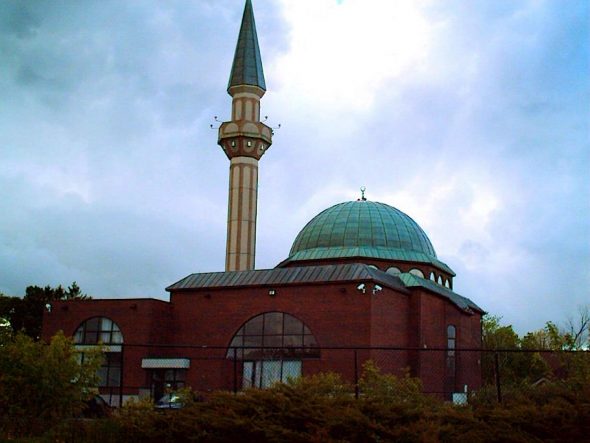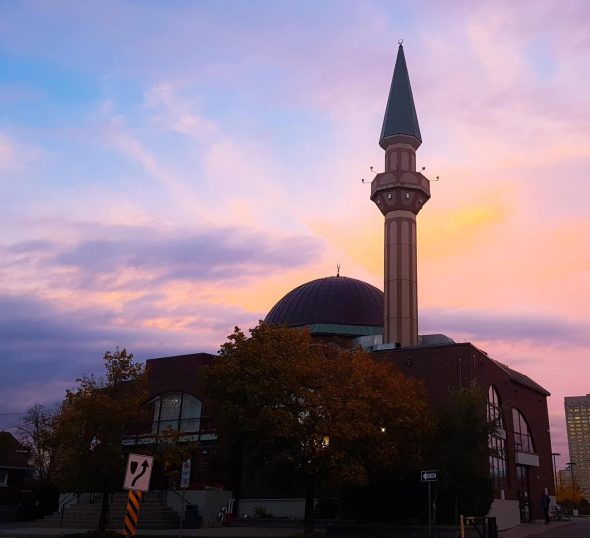
Ottawa Mosque, 251 Northwestern Avenue, 2009, by Muhammad, Wikipedia
Ottawa’s First Mosque by James Powell from Today in Ottawa’s History
According to a 1995 Citizen article, the first Muslim immigrants to Ottawa were Hassan Mahmood Wahad and his family, who came to the capital in 1903 from the small Lebanese-Syrian town of Kfarmishki, located about 90 kilometres southeast of Beirut.
At the time, the community was part of the Ottoman Empire.
The Wahad family found a home in the Byward Market alongside other recent immigrants.
It must have been difficult.
Initially knowing little English or French, Hassan Wahad and his family were cut off from their language, culture, and religion.
Somehow, Hasan Wahad made a living as a pedlar, selling small items door to door.
Other Lebanese families from Kfarmishki, including the Boushey family who became well-known in the capital for their landmark grocery store on Elgin Street, later joined the Wahad family in Ottawa.
Hassan Wahad made it to the local newspapers in 1924, when he appeared as a witness in a bigamy case involving two other members of the small but growing Muslim community in the city.
Wahad gave evidence of marriage practices in Muslim Syrian communities.
(The bigamy case was dismissed for lack of evidence.)
Wahad’s second daughter, Afefe, was the first Muslim person born in Ottawa.
At school, Afefe became known as Eva.
This moniker stuck for the rest of her life.
Eva Wahad was to play a key role in the establishment of the first mosque in Ottawa.
It was years before Ottawa’s Muslim community was large enough to consider the possibility of building a mosque.
By the early 1960s, there were still less than five hundred Muslims living in the city.
Prayers at major religious festivals such as Eid-al-Fitr and Eid-al-Adza were held at the Pakistan High Commission and the Egyptian Embassy.
(Eid-al-Fitr marks the end of the month-long period of fasting of Ramadan. Eid-al-Adza, the Feast of Sacrifice, honours the willingness of Abraham to sacrifice his son Ismail [Peace be upon them] in an act of obedience to Allah.)
At the 1962 Eid-al-Fitr observance at the Pakistan High Commission, four Ottawa Muslims proposed the creation of an Ottawa Muslim Association (OMA) with the objective of building a mosque.
Three reasons were cited for its construction.
First, the mosque was to serve the religious needs of the growing Muslim population of Ottawa.
Second, it would help Muslim children stay connected with their heritage.
Third, the mosque would promote better understanding among peoples of different faiths.
The Muslim Women’s Auxiliary, which was founded by Eva Wahad, was tasked with the objective of raising money for the mosque’s construction fund.
In 1962, Ottawa’s Muslim community began to hold weekly prayers at the Western United Church located at the corner of Wellington and Bronson Streets.
When that building was demolished in 1965, the community’s services were moved to Northwestern United Church on Northwestern Avenue close to Scott Street.
Also in 1965, the OMA was officially incorporated.
For the next ten years, Ottawa’s Muslims scrimped and saved.
The Ottawa Muslim Association recommended that community members donate ten days’ salary each year to the building fund.
Eva Wahad organized hundreds of events to raise funds including cultural activities, teas, and even pork-free, Chinese cooking lessons.
Roughly half of the more than $500,000 ultimately needed to construct the mosque was provided by Muslim countries, including Saudi Arabia, Iraq, Iran and Malaysia.
By 1967, the Association had raised the $25,000 needed to purchase a plot of land beside the Northwestern United Church.
The spot was ideal.
It was serviced by three bus routes, was fairly central, and not too close to its neighbours.
On the land was two old houses.
One was rented out while the other was used for programs.
For many years, funerals and marriages had to be performed by an Iman brought from Detroit.
By the late 1960s, Dr. Farid R. Ahmed, a National Research Council physicist and the first OMA president, was able to able to perform these rites.
He later became chair of the mosque construction committee.
In 1972, the OMA announced that Ottawa would finally get its first mosque to be located on the Northwest Avenue property.
While all the funds necessary for construction the mosque had not yet to be donated, the organization was able to proceed with its plans.
The building, with a traditional Islamic dome and 115-foot minaret, was designed by Toronto architect Anwar Asad.
The call to prayers made five times a day would be delivered using an electronic amplifier.
The building would be oriented so that worshippers would facing east.
As is customary with all mosques, there would be no chairs or pews.
Prayers would be made kneeling on carpets.
Consistent will Islamic practice, men would pray in front, then boys, then women and girls.
City hall gave the go-ahead to build the mosque in early March 1973, but not before a few hiccups.
Plans for the site incorporated only twenty parking spaces instead of twenty-six as initially required by the city’s planning department.
After the Board of Adjustments approved a variance, the City appealed, concerned about crowding on neighbourhood streets.
However, the appeal failed since the relevant city by-law governing the required number of parking spots for a house of worship was based on the number of seats or pews, whereas a mosque had no seats or pews.
Mayor Benoit also noted that a shortfall of six parking spots would make no appreciable difference to neighbourhood congestion.
With this last hurdle passed, tenders were sent out.
Ground was broken at 251 Northwestern Avenue in September 1973.
Two young children, Basher Ghadban and Yasmine Ismaily, turned the first sod with G. K. Chaudhry, the then president of the OMA, and other members of the Muslim community looking on.
Eighteen months later, on 26 March 1975, prayers were held for the first time in the new Ottawa mosque.
While the upstairs dome and minaret were not yet complete, building inspectors had given their permission to use the basement.
In the inaugural congregation were ambassadors from Muslim and Arab countries.
That September, Eid-al-Fitr (marking the end of Ramadan) was celebrate for the first time in the mosque.
By now, evening and Sunday prayers (not Friday) had already started, with plans underway to commence weekend Islamic classes.
In late February 1976, with the upstairs building still unfinished, prayers in the basement were disrupted by protests at the visit of Pakistan’s then prime minister Zulfikar Ali Bhutto.
Bhutto, who was visiting Ottawa, had come to the mosque to pray and to pledge funds to the mosque’s building fund.
A Pakistani couple who had been separated from their children by the 1972 civil war that had led to the independence of Bangladesh interrupted prayers to present a petition to Bhutto asking for his intervention to bring their children to Canada.
Their earlier efforts to do so had been thwarted by death threats.
Mosque officials allowed the couple to present their petition to Bhutto.
However, a shouting match broke out afterwards between supporters of the couple and others in the hall.
Bhutto was whisked away by RCMP officers.
Two demonstrators were detained but subsequently released without charge.
The following year, Zulfikar Ali Bhutto was ousted in a military coup by General Muhammad Zia-ul-Haq, and was controversially executed in 1979.
After some minor last-minute finishing touches, including the installation of handrails, building inspectors gave the upstairs portion of the glass and steel mosque the green light at the end of February 1977.
Although ready for occupancy, its interior was empty.
There was not even a pulpit in place, as the one promised by Egypt had not yet arrived.
Nevertheless, on 3 March 1977, Ottawa’s Muslim community was able to celebrate Eid Milad-un-Nabi in honour of the birth and life of Mohammed [pbuh].
School children gave poetry recitals.
There were also prayers and a talk on the Prophet’s life [pbuh].
In early July 1977, Eva Wahab and the Ottawa Muslim Women’s Auxiliary hosted an “open house” at the mosque and tea to the people of Ottawa of all faiths.
Today, the Ottawa Mosque and the Ottawa Muslim Association remain central to the life of the capital’s Muslims.
However, the size of the Muslim community has grown rapidly since the opening of the mosque on Northwestern Avenue, augmented by new arrivals, most recently from war-torn Syria and Somalia.
With the number of Muslims now accounting for about 10 per cent of the population of Ottawa-Gatineau, or roughly 140,000 people, the Ottawa Mosque cannot accommodate them all at prayers.
Consequently, additional mosques have opened across the region.
Eva Wahad and Dr. Farid Ahmed, the two Muslim pioneers who led the movement to build the first mosque in Ottawa, died in 2005 and 2021, respectively.
Sources:
Durrani, Palvashah, 2014. First Muslim Born in Ottawa: Visionary & Community Builder Eva Wahab, Muslim Link, 3 October.
Khalfan, Zufl M., 2021. Farid Ahmed: A Pioneer Muslim Passes Away, 20 December.
Ottawa Citizen, 1962. “Moslem Group Plans to Have Ottawa Mosque,” 5 April.
——————, 1969. “Muslim women are cooking up a mosque,” 8 February.
——————, 1970. “Religion can still save a troubled world,” 23 July.
——————, 1972. “Malaysia donates $5,000 to Ottawa mosque project,” 4 March.
——————, 1973. ‘City’s 1st mosque plan gets all-clear,” 9 March.
——————, 1973. “Ottawa’s Muslims will get their mosque,” 9 June.
——————, 1975. “Moslems hold first prayers in new mosque,” 20 September.
——————, 1976. “Capital Diary,” 18 February.
——————, 1976. “Bhutto church visit disrupted,” 23 February.
——————, 1977, “Ottawa mosque nearly complete,” 5 February.
——————, 1977. “Moslems to mark their ‘Christmas.’” 22 February.
——————, 1977. “Open house,” 9 July.
Ottawa Journal, 1972. “City will hear call to Allah,” 2 June.
——————-, 1975. “Muslim pioneers build a future,” 17 May.
——————-, 1976. “Hard work built Mosque,” 9 December.
Ottawa Mosque, 2023. About OMA.
